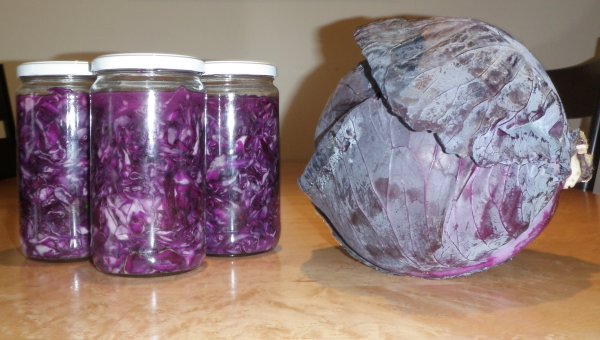If you want the highest quantities and diversity of probiotics with every meal, you need a fresh supply of living probiotics. This is where drinks or starter cultures such as cabbage rejuvelac shine. Drink a 1/4 cup of this at the start of every meal, and you’ll out-do any probiotic pill by miles. And because the probiotics have already broken the cabbage down, those of us who normally can’t digest cabbage tend to have few to no problems with rejuvelac. This post discusses the importance of probiotics and how to make them yourself.
This post was written by Jackie McMillan and originally published on September 10, 2014.
Many of us today are living with gut dysbiosis (the wrong creatures in the gut, manufacturing toxins that impair emotional balance, mental functioning, and physical strength, ability, and immune capacity). Probiotics can help.
Ways to Acquire Probiotics
There are a growing number of ways to add probiotics into your diet:
- You can take expensive probiotic pills with every meal. The best of these pills have 11 species, or maybe, if you’re lucky, 17 species of probiotics in them. Some of these probiotics are grown on foods that hurt autistics, either through allergies, or through sensitivities… and some autistics are sensitive enough that this is a problem. Most of these probiotics die off over time in the pills (their original usefulness rapidly falls off), and they are usually delivered in their dry, “seed” form. From this dry form, it takes a little water and time for them to perk up and get to work digesting.
- You can wait for the latest designer probiotics emerging from the expensive human microbiome research. These will have thousands of species in them which are sourced from healthy human digestive systems, tested for pathogens, and then packaged for consumption. However, these are likely to cost much more that the existing probiotic pills. And these also arrive in dry or “seed” form. And they’re still being tested, so are hard to get hold of…
- You can get sick enough (and you have to be very sick, indeed) that your doctor refers you to get a fecal transplant. Feces from a healthy person are then surgically transplanted into your colon, and if you’re lucky, that person’s healthy gut microbes push out the scavengers and opportunists that have been wreaking havoc in your gut, in the meantime. If you aren’t lucky, the healthy gut bugs (probiotics) lose the war, and you’re left to recover from the surgery (much harder when your bad gut bugs aren’t letting you get the nutrients you need) without a newly-healthy gut.
- You can look at where healthy gut bugs come from in the first place, and make your own probiotics. The probiotics you make yourself will have thousands of species of the gut bugs which are already adapted to breaking down the foods that you eat, in living form (not dry or “seed” form). This is very inexpensive, very simple, and requires very little in the way of equipment.
If you’ve bumped into my work before, you know that I’m constantly seeking for DIY (do-it-yourself) options for health recovery. So when I began to learn about my gut biology, and how it was causing a good portion of my brain fog, emotional turmoil, and aching joints and muscles, I started looking for options.
Acquiring Probiotics Naturally
The thing is, if you look at the healthiest people all around the world, they don’t generally live in big cities. They live rurally, often in small villages, and they eat local foods which haven’t been fertilized or sprayed with anything manufactured. What’s really interesting is that these people’s gut biologies are VERY different from each other’s, depending on the environment they live in, and what they eat.
It turns out that there are millions of species of micro-organisms which can live in the human gut, forming very different ecosystems… Hmm, let me reframe that. If we were to compare a rainforest in Brazil with a rainforest in Asia, most of the species would be different between those two rainforests.
But there would be amphibians, birds, and plants filling different roles in those ecosystems, and the ROLES needing to be filled are almost identical. This is what the gut ecosystem is like. In different locations on earth, different micro-organisms take the necessary gut ecosystem roles, but the roles are the same.
So where are these micro-organisms coming from? The simplest answer is: from our mothers during birth. There’s a reason we arrive through the birth canal facing our mother’s anus. Babies born through Cesarean section have skin micro-organisms in their gut, instead of gut micro-organisms, and tend to be more prone to immune and other challenges.
However, there’s a more complicated and empowering answer than how you arrive at birth.
Every plant food that grows has, on its skin, a collection of micro-organisms waiting for a cut, a crush, or a bruise to release some of the food that plant makes for itself. The micro-organisms that cluster in wait are all ideally suited to eating – or to breaking down – that particular food source. And when they get access to that food, they have a population explosion…
These micro-organisms are not only best suited to that plant, they are also highly adapted to the climate where that plant grows. They can deal with drought, or periodic flooding, or harsh winters, or high heat. And they confer some of that unique resilience to any organism they co-operate with…
So each ecosystem has different micro-organisms in it, and of those, some are ideally suited to breaking down the plants from that ecosystem which we humans call “food”. And these micro-organisms tend to be the ones that are happily occupying the guts of the healthiest people on earth, according to their unique surrounding ecosystem.
Right, so this has bigger implications in terms of eating local, unsprayed foods from healthy soils, but we’re not going to go into that right now. For now, we’re going to go back to the lowly, humble, and odoriferous cabbage. That is, it has a slight sulphur smell itself, but the odours it makes in the unhealthy human gut are something else!
Acquiring Probiotics through Cabbage
Cabbage family plants are high in medicinal qualities, and high in nutritional value. And on every cabbage leaf rests a white film, a “bloom” which can be wiped off (but which is ideal to leave in place). This bloom contains hundreds and more of different species of probiotic micro-organisms.
Washing or soaking that cabbage leaf in chlorinated or otherwise contaminated water will kill many if not all of these… which gives you some clues about how we have killed off so many of the healthy creatures that ought to be supporting our digestion!
So how do we get the probiotics off the cabbage leaf, and happily ensconced in our digestive systems?
First, we have to encourage a probiotic population explosion. Then we need to shift our gut ecology so that the probiotics can survive in the gut conditions present (and many of the bad gut bugs make the digestive environment too toxic for the probiotics to live for long). This shifting process goes faster the younger you are, the more things you’re doing to support the probiotics, and the more things you’re doing to weaken the bad gut bugs.
While we’re doing this gradual shift of the gut ecosystem back to health, one of the best things we can do is to have some probiotics, live and fresh, with every meal. Lacto-fermented pickles like kimchi and sauerkraut can do this, but while those pickles often have way more probiotics in both variety and quantity than a pill would have, many of the species have been outcompeted and are no longer present live, and many others have gone into “seed” form.
If you want the highest quantities and diversity of probiotics with every meal, you need a fresh supply of living probiotics. This is where drinks or starter cultures such as cabbage rejuvelac shine. Drink a 1/4 cup of this at the start of every meal, and you’ll out-do any probiotic pill by miles. And because the probiotics have already broken the cabbage down, those of us who normally can’t digest cabbage tend to have few to no problems with rejuvelac.
So how do you make cabbage rejuvelac?
- 3 cups finely chopped organic cabbage
- 3.5 cups filtered or safe spring water (e.g. no solvents, fertilizers, or fecal residues from livestock)
- 1 large (close to 2 litres) sterile jar with sealer lid
- 1 blender
Put the chopped cabbage and filtered water into the blender and purée. Pour into the large sterile jar, and put the sealer lid on. The inexpensive option is to leave that lid slightly loose, so gases can escape as those micro-organisms in the bloom start to break the cabbage solids down and release gases. Slightly less inexpensive is to put a winemaker’s airlock onto a canning jar lid, so that no micro-organisms can leak back in. This second option keeps your probiotic blend much healthier for the anaerobic (don’t like oxygen) critters which are best for the belly.
Leave that jar somewhere out of direct sunlight, and in a warmer spot if your kitchen is cool (the top of the fridge works well for me). 48 hours later, strain the liquid through a cloth-lined sieve (squeezing the liquid out of the cloth is fine), and pop the liquid rejuvelac into your fridge. Use 2 Tbsp. for jump-starting lacto-fermented pickles, and the same amount for getting your seed and nut sour creams started.
I first found this recipe in Robert Gray’s book, 10th revised edition, “The Colon Health Handbook”, and it’s been one of my best kitchen treasures. Hope you enjoy it too, and I’ll look forward to hearing about your fermentation experiments with it, below!
Parents, educators, health professionals, and autistic spectrum adults continue to benefit from Jackie’s plain-language talks, programs, materials, and mentoring around maximizing quality of life and function for people living with autism. Jackie lives by the motto: If you know things have to change, you might as well enjoy it!
For more information about Jackie’s work, visit: ThriveWithAutism.ca

